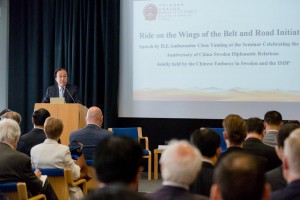北欧绿色邮报斯德哥尔摩报道(记者陈雪霏)--由中国驻瑞典大使馆和瑞典安全与发展政策研究院联合组织的“一代一路战略--中瑞关系下一个65年发展机遇“研讨会9日在斯德哥尔摩举行。
陈育明大使在会上致辞说:所谓“一带一路”,指的是“丝绸之路经济带”和“二十一世纪海上丝绸之路”,前者是横跨亚非欧,绵延7000多公里,囊括30亿人口的巨大经济带,被誉为“世界上最长、最具有发展潜力的经济大走廊”。后者则是途径东亚、东南亚、南亚、中东等多个区域,连接太平洋、印度洋和大西洋的重要海上通道。“一带一路”以沿线中心城市为支撑,以重点经贸产业园为合作平台,以重点港口为节点,将活跃的亚太经济圈和发达的欧洲经济圈更紧密地联系在一起,释放广大腹地国家的巨大发展潜力。
他说:众所周知,古代海、陆丝路交相辉映,亚洲、欧洲、非洲各国人民互通有无,守望相助,共同谱写了人类文明的华彩乐章。“一带一路”正是对古代丝路精神的传承与发展,旨在使古丝路精神焕发新的活力,使亚欧非多国联系重新紧密,推动互利合作实现新的历史规模。“一带一路”不是哪一家的独奏,而是沿线国家的合唱。中国愿同各国共同构建合作共赢的伙伴关系,实现多元、自主、平衡、可持续发展。
“目前,“一带一路”建设正步入务实合作新阶段。沿线60多个国家以及欧盟、东盟、上合组织及联合国亚太经社理事会等国际组织积极回应,中国政府已制定并公布了愿景与行动文件。一批基础设施互联互通项目正在稳步推进。相信在不久的将来,沿线各国将逐步收获“一带一路”带来丰硕成果。”
一带一路战略研讨会在斯德哥尔摩举行。 图文 陈雪霏
中国驻瑞典大使陈育明在接受北欧绿色邮报网记者采访时说,本次研讨会的主要目的是在庆祝中瑞建交六十五周年之际,探讨在一带一路战略框架下相关国家包括中瑞之间能够有什么样的合作和发展机遇。
(请听采访陈大使音频Interview with Chinese Ambassador Chen Yuming)
“我相信本次研讨会是富有建设性的,有利于促进中国与相关各国包括中瑞之间的投资与合作,对与会者和瑞典公众了解一带一路战略都是大有益处的。” 陈大使说。
瑞典安全与发展政策研究院主任尼古拉. 斯万斯特罗姆(Niklas Svanström)告诉北欧绿色邮报网记者,本次研讨会是他们组织的有关纪念中瑞建交65周年系列活动之一。同时,他认为,既然“一带一路”战略对中国的经济发展,中国与外界联系都是非常重要的,同样,这对欧洲与亚洲的联系也是非常重要的。因此,他认为,欧洲在基础设施规划和投资时,也要考虑中国的一带一路战略。如果双方真能互相联系起来发展,必将对中欧的经济发展是一笔宝贵的财富。
(请听采访Svanström Interview with Niklas Svanström from ISDP)
当记者问他所看到的机遇有哪些时,他说,基础设施方面,投资方面,都有合作潜力,例如,中国已经建立了丝绸之路基金,欧洲也应该建立类似的基金,相互协调,我们不一定什么问题都能达成一致,但是,我们可以相互协调得比现在更好一些。
本次研讨会由中国大使陈育明首先致辞。瑞典商务部秘书Oscar Stenström,也在开幕式上作了讲话。瑞典中亚大使彼得森,中银国际控股有限公司首席经济学家,中国人民大学经济学院教授、博士生导师,美国南加洲大学客座教授,上海交通大学兼职教授,北京大学经济研究中心 研究员曹远征也应邀参加研讨会。
来自企业界的华为中东欧和北欧地区CEO佛雷德里克森也出席了会议。他在接受本网记者采访时说,华为的远景就是要靠公开透明的竞争来实现双赢。而“一带一路战略”正好与他们的远景相似。通过合作,各国在各种规则制定方面多合作,少冲突,有利于实现共同增长。华为的主要使命就是让世界联系起来。他们多年的实践发现,一个国家电信方面增加1%,GDP可以增加1.4-1.5%,因此,投资电信是非常有经济效益的。
(请听采访华为音频:Interview with Mr. Kenneth Fredriksen from Huawei)
“当然,对于中国的“一带一路”战略,有些想关国家有疑虑,一直在怀疑中国的真实目的,我认为,国与国之间只有合作,才能谋求共同发展。我认为中国的一带一路战略会对相关国家带来非常积极的影响,如果相关国家能够在规则,法律,政策等方面进行协调,这对我们这样的民营企业会间接地有很大好处。我相信,人们会理解一带一路的积极影响,但会需要一段时间。“
大约100多人参加了在外交部街地中海会议厅举行的研讨会。瑞典铜矿公司执行主任兼瑞典皇家工程院副院长和秘书佩尔.斯多姆也参加了讨论,并对一带一路对他们的影响谈了看法。
有代表提出是否在教育方面能促进中欧合作,斯多姆表示,瑞典铜矿开发方面非常重视环境影响问题,在这方面有很好的知识和经验,瑞方愿意在这方面进行教育合作。






